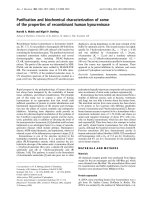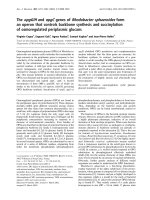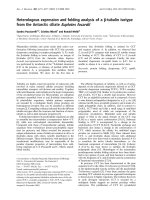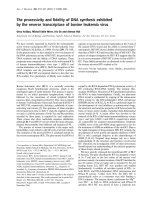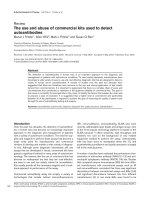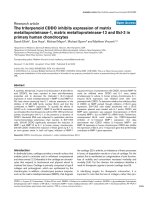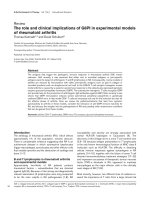Báo cáo y học: "The personal and national costs of mental health conditions: impacts on income, taxes, government support payments due to lost labour force participation" pot
Bạn đang xem bản rút gọn của tài liệu. Xem và tải ngay bản đầy đủ của tài liệu tại đây (190.73 KB, 7 trang )
RESEARCH ARTICLE Open Access
The personal and national costs of mental health
conditions: impacts on income, taxes,
government support payments due to lost labour
force participation
Deborah J Schofield
1*
, Rupendra N Shrestha
2
, Richard Percival
3
, Megan E Passey
4
, Emily J Callander
1
and
Simon J Kelly
3
Abstract
Background: Mental health conditions have the ability to interrupt an individual’s ability to participate in the
labour force, and this can have considerable follow on impacts to both the individual and the state.
Method: Cross-sectional analysis of the base population of Health&WealthMOD, a microsimulation model built on
data from the Australian Bureau of Statistics’ Survey of Disability, Ageing and Carers and STINMOD, an income and
savings microsimulation model was used to quantify the personal cost of lost income and the cost to the state
from lost income taxation, increased benefits payments and lost GDP as a result of early retirement due to mental
health conditions in Australians aged 45-64 in 2009.
Results: Individuals aged 45 to 64 years who have retired early due to depression personally have 73% lower
income then their full time employed counterparts and those retired early due to other mental health conditions
have 78% lower incomes. The national aggregate cost to government due to early retirement from these
conditions equated to $278 million (£152.9 million) in lost income taxation revenue, $407 million (£223.9 million) in
additional transfer payments and around $1.7 billion in GDP in 2009 alone.
Conclusions: The costs of mental health conditions to the individuals and the state are considerable. While
individuals has to bear the economic costs of lost income in addition to the burden of the conditions itself, the
impact on the state is loss of productivity from reduced workforce participation, lost income taxation revenue, and
increased government support payments - in addition to direct health care costs.
Background
Mental health conditions are a highly prevalent condition
in numerous countries [1]. Within Australia it is the
third largest proportion of the burden of disease [2]. In
2007, almost half of the Australians aged 16 to 84 ha d
experienced a mental health condition at some stage in
their lives, and in 2005 the prevalence rate of long-term
mental illness was 11% (a figure which has progressively
increased since 1995) [3,4].
Due to the high prevalence rates, the economic costs of
mental health conditions are large [1]. In Australia in
2004-05, AU$4.1 billion (£2.3 billion) was allocated to be
spent on mental health [5]. In the United Kingdom in the
same period the £4.5 billion was invested in adult mental
health services [6]. In addition to these large national
costs, the personal economic costs are also great: people
with mental health conditions are recognised as being
some of the most socially margina lised and economically
disadvantaged members of the community [7].
Mental health conditions have significant impacts on
an individual’s employment. The labour force participa-
tion rates of people w ith a mental health condition are
generally poor - people with a mental health condition
* Correspondence:
1
NHMRC Clinical Trials Centre and School of Public Health, University of
Sydney, Camperdown, NSW 1450, Australia
Full list of author information is available at the end of the article
Schofield et al. BMC Psychiatry 2011, 11:72
/>© 2011 Schofield et al; licensee BioMed Central Ltd. This is an Open Access article distributed under the terms of the Creative
Commons Attribution License (http ://creativecommons.org/licenses/by/2.0), which permits unrestricted use, distribution, and
reproduction in any medi um, provided the original work is properly cited.
have unemployment levels of 75-90% in the US; and
61-73% in the UK. Within Australian individuals with a
mental health condition have unemployment rates up to
four times higher than healthy Australians [8].
While less prevalent in older age groups [9], older work-
ers who suffer from mental health conditions may be
more likely to retire from the workforce early, due to a
combination of the effects of ageing and the disabling
impacts of the mental health condition [8]. Indeed, within
Australia more than half of those w ith a mental health
condition who are aged 45 to 64 years are not in the
labour force (106 100 individuals) [10] and this results in
reduced savings for these individuals [11].
However, there have been no detailed, comprehensive
studies on the economic impacts of early retirement due
to mental health conditions to both the individual and
the state in Australia. The studies that have l ooked at the
indirect costs of mental illness h ave generally focused
only on loss of income from wages and salaries. They
exclude, for example, reduction in income from other
sources and for government reductions in income taxa-
tion revenue and an increase in social security payments.
This paper q uantifies, for the 45 to 64 year old Australian
population, the amount of income available to those who
have retired early due to depression and also for those with
other mental health conditions, the amount of taxation
revenue these individuals pay to the Australian govern-
ment, and the amount of g overnment benefits paid to
these individuals. It will quantify the difference of these
values between those who have retired early due to depres-
sion and other mental health conditions and those in the
labour force with no health condition to give a more com-
plete picture of the costs of mental health conditions, and
show how much better off the effected individuals and the
government would be if the conditions had been prevented
and individuals remained in the labour force. It also q uanti-
fies the aggregate cost to the state from lost taxation
revenue, increased social welfare payments, and estimates
the national GDP loss due to individuals exiting the
labour force due to depression and other mental health
conditions.
Methods
Data
The output dataset of a microsimulation model,
Health&WealthMOD, which is Australia’ s first microsi-
mulation model of health and dis ability, was used to ana-
lyse the associated impacts that ill health has on labour
force participation, personal income, and government
revenue and expenditure. It was specifically designed to
measure the economic impacts of ill health on Australian
workers aged 45 to 64 years.
The base population of Health&WealthMOD was unit
record data extracted from the Survey of Disability, Ageing
and Carers conducted by the Australian Bureau of Statis-
tics in 2003 [12]. From this dataset, individual records
were extracted for those aged 45-64 years. The details
extracted for each individual in the base population
included demographic variables (for example, age, sex,
family type, state of residence, and ethnic background),
socioeconomic variables (level and field of education,
income, benefits received), labour force variables (labour
force participation, employment restrictions, retireme nt),
and health and disability variables (chronic conditions,
health status, type and extent of disability, support and
care required).
Using a separate microsimulation model–STINMOD–
additional economic information such as individual
income, government support payments and tax liability
was imputed onto the base data. STINMOD is Australia’s
leading model of income tax and government support
payments [13,14] and is maintained and developed for
the Australian Government by the National Centre for
Social and Economic Modelling. Income and wealth
information was imputed onto the base population of
Health&WealthMOD by identifying persons with similar
characteri stics on STINMOD and “ donating” their
income and wealth information onto
Health&WealthMOD using a process commonly used in
microsimulation modelling called ‘synthetic matching’
[15]. Nine variables: sex (2 groups), income unit type
(4 groups), type of government pension/support (3 groups),
income quintile (5 groups), age group (4 groups), labour
force status (4 groups), hours worked per week (5 groups),
highest educational qualification (2 groups) and home
ownership (2 groups), that were common to both datasets
and str ongly related to income were chosen as matching
variables for synthetic matching. To check the assumption
that the information contained on the STINMOD records
accurately reflected the economic stat us of those records
on the 2003 SDAC they were matched with, the accuracy
of the matching of these variables were checked. It was
found that each of the matching variables on each record
were matched within a 5% accuracy, except for age, which
was matched within 6% accuracy [16]. Due to the very
small matching error it is not expected that the results in
this study will be meaningfully affected.
The data were then aged to reflect the 2009 Australian
45 to 64 year old population. The up-rating was used to
account for the disabilit y and illness, demographic,
labour force, earnings growth and other changes that
had occurred between 2003 and 2009. The process by
which Health&WealthMOD was built is outlined in
detail in Schofield et al. [17].
The Survey of Disability, Ageing and Carers provides
detailed self-reported data on socio-demographic status,
labour force participation and health and disability sta-
tus (such as chronic conditions) for each individual in
Schofield et al. BMC Psychiatry 2011, 11:72
/>Page 2 of 7
Health&WealthMOD. Respondents health conditions
were classified by the Australian Bureau of Statistics
using ICD10 codes which were developed by the World
Health Organisation and endorsed by the 43
rd
World
Health Assembly in 1990 [18]. People who reported
their main long term health condition as depression/
mood affective disorders (excluding p ostnatal depres-
sion) (ICD code F30-39) were considered to have
‘depressio n’. Those who reported their main long term
health condition as mental and behavioural disorders,
dementia, schizophrenia, phobic and anxiety disorders,
nervous tension/stress attention deficit disorder/hyper-
activity, and other mental and behavioural disorders
(ICD codes F00-29, F40-99) were categorised as ‘other
mental health conditions’ for this study. Depression was
analysed separately from other mental illnesses due to
its high prevalence in the population.
In this study those who reported to be out of the
labour force due to their illness and listed depression as
their main condition were considered to be out of the
labour force due to depression. Those who reported
being out of the labour force due to their illness and
listed one of the other mental health conditions as their
main condition were deemed to be out of the labour
force due to other mental health conditions. All people
who are out of the labour force, regardless of the reason
for it, are assumed to be permanently retired.
Statistical methods
Initial descriptive analysis was undertaken to determine
the mean and median weekly income, taxation payments,
and social security benefits attributable to individuals
employed full time, employed part time, not in the labour
force due to depression and and not in the labour force
due to other mental health conditions. Income was
defined as total gross income from all sources, including
employment earnings, transfer income, and income from
other sources such as investment properties. A multiple
linear regression model of the log of weekly income was
used to anal yse the differences between weekly incomes
of people in the labour force (full-time and part-time)
with no health condition and people not in the labour
force due to depression and due to other mental health
conditions. Analyses were repeated for weekly transfer
income and weekly tax liability. Age group, sex and high-
est education were adjusted for in a ll regression models.
Regression analysis was undertaken on log-transformed
data in order to satisfy the assumptions of linear regres-
sion analysis, and regression diagnostics confirmed that
the assumptions were reasonably satisfied.
The national economic impacts of depression and other
mental health conditions, whe n it leads t o exit from the
labour force were estimated with the assumption that
people who reported being out o f the labour due to
depression or other mental health conditions would have
the same labour force participation rates as of the people
with no chronic condition if they did not have the mental
health condition. Some of the se people who were out of
the labour force due to depression and other mental
health conditions might still have other chronic conditions
other than the mental health conditions (which they cite
as their main condition). These other conditions might
keep them out of the labour force even if they did not
have depression and other mental health conditions. How-
ever, there was no data available to estimate what propor-
tion of these people would be out of the labour force due
to other chronic conditions if they did not have depression
and other mental health conditions. Thus, we conducted a
sensitivity analysis assuming:
(1) that if individuals who were out of the labour
force due to depression and other mental health
conditions did not have these conditions that they
would otherwise have had the same labour force
participation rates as people with no chronic health
conditions, or
(2) that individuals who were out of the labour force
due to depression and other mental health condi-
tionswouldotherwisehavehadthesamelabour
force participation rates as people with c onditions
other than depression and other mental health con-
ditions. This assumption was used a s the sensitivity
analysis for estimating the national economic
impacts.
The impact of depression and other mental health
conditions on national GDP was calculated based on the
Commonwealth Treasury’s GDP formula:
GDP =
(
GDP/H
)
×
(
H/EMP
)
×
(
EMP/LF
)
×
(
LF/Pop15+
)
× Pop15
+
where GDP = Gross Domestic Product; H = total
hours worked; EMP = total numb er of persons
employed; LF = total labour f orce; and Pop15+ =
population aged 15 years and over [19]
The analyses were undertaken usi ng SAS V9.1 (SAS
Institute Inc., Cary, NC, USA). All statistical tests were
two sided with the significance level set at 5%. Currency
figures are given in 2009 Australia dollars - 1Austr alian
dollar = approximately 0.55GBP in 2009. In 2009 the
Purchasing Power Parity (PPP) was 1.46 for Australia
and 0.619 for the United Kingdom with the United
States being 1. PPP represented the number of monetary
units to buy the same representative basket of consumer
goods and services [20].
Schofield et al. BMC Psychiatry 2011, 11:72
/>Page 3 of 7
Results
Amongst those surveyed in the Survey of Disability,
Ageing and Carers who were aged between 45 and 64
years, there were 43 individuals who were out of the
labour force due to depression, and 54 individuals who
were out of the labour force due to other mental health
conditions; there were 2 273 who were employed full
time with no chronic h ealth condition, and 781 who
were employed part time with no chronic health condi-
tion. Once weighted, these data represented 25 200 indi-
viduals not in the labour force due to depression, 35 200
individuals not in the labour force due to other mental
health conditions, 1, 410, 000 individuals employed full
time with no chronic health condition, and 421 300
individuals employed part time with no chronic health
condition within the Australian population aged 45 to
64 years.
Those who were out of the labour force due to depres-
sion had a median weekly income (income from all
sources, including government transfer income) of $3671
(£202), and those out of the labour force due to other
mental health conditions $312 (£172). This is around half
of the median weekly income of those employed part-
time with no condition ($657 per week (£361), and
around one-quarter of the media n weekly income of
those employed full time with no c hronic condition, $1
226 (£ 674) (Table 1).
Of their total weekly income - those not in the labour
force due to depression received a median value of
weekly transfer income of $254 (£140) (government sup-
port payments) and those not in the labour force due to
other mental illnesses received $274 (£151); whereas
those in employment receive none (as a median value).
Not being in employment and typically with little or no
other income, those out of the labour force due to
depression and other mental illness paid a median value
of zero in tax per week - whereas those employed full-
time pay a median value of $223 (£123) per week in tax.
When compared to those with no health condition in
full time employment and adjusted for age, sex and edu-
cation, those out of the labour force due to depression
receive 73 per cent less per week on average in total
income (Table 2), and those out of the labour force due
to other mental health conditions receive 78 per cent
less. They also pay almost 100 per cent less per week in
taxation, and receive significa ntly more in government
transfer payments.
Those employed part-time with no long t erm health
condition also have significantly lower incomes, pay less
taxation, and receive more in transfer payments than
those employed f ull time. However the percentage dif-
ferences between those employed full time and those
employed part time, is not as great as those employed
full time and those not in the labour force due to men-
tal health conditions (Table 2).
When aggregated, the national impact of depression
when it leads to exit from the labour force is $1 billion
(£0.55 billion) in lost income, $154 million (£84.7 mil-
lion) in lost taxation revenue, and an additional $129
million (£71.0 million) in government transfer payments
per year. When aggregated, the national impact of
labour force exit due to other mental health conditions
is $1.5 billion (£0.83 billion) in lost income, $124 million
(£68.2 million) in lost taxation revenue, and an addi-
tional $278 million (£152.9 million) in government
transfer payments per year (Table 3) a ssuming that
otherwise those with mental health conditions would
have had t he same labour force participation rates a s
people with no chronic health conditions. The results of
the sensitivity ana lysis show that lost income, tax and
additional social security payments would be ab out 10%
lower if it were assumed that if individuals who were
out of the labour force due to mental health conditions
would otherwise have had the same labour force partici-
pation rates as people with conditions other than mental
health conditions.
Table 1 Average and median* weekly income, transfer payments and tax liability by labour
Labour Force Status Weekly income AU$ (£) received by
individuals
Weekly transfer income AU$ (£)
received by individuals
Weekly tax liability (includes Medicare
levy) AU$ (£) paid by individuals
Mean SD Median Mean SD Median Mean SD Median
Employed fulltime, no
chronic health condition
1 507 (£829) 33 575 1 226 (£674) 9 (£5) 1 082 0 (£0) 344 (£189) 11 746 223 (£123)
Employed part time, no
chronic health condition
657 (£361) 11 714 559 (£307) 28 (£15) 1 661 0 (£0) 78 (£43) 3 066 30 (£17)
Not in labour force due
to depression
367 (£202) 6 147 286 (£157) 228 (£125) 3 563 254 (£140) 15 (£16) 1 143 0 (£0)
Not in labour force due
to other mental health
conditions
312 (£172) 4 705 310 (£171) 274 (£151) 3 952 281 (£155) 0 (£0) 27 0 (£0)
*all results given in 2009 Australian dollars (AU)
Schofield et al. BMC Psychiatry 2011, 11:72
/>Page 4 of 7
As a result of the 25 200 workers missing from the
labour force due to early retirement as a result of
depression, there is a annual loss of $698 million
(£383.9 million) in GDP. As a results of the 35 200
workers missing from the labour force due to early
retirement as a result of other mental health conditions,
there is a annual loss of $975 million (£536.3 million) in
GDP.
Discussion
The costs of depression and other mental health condi-
tions are considerable both at the individual le vel and at
the aggregate national level. Individuals aged 45 to 64
years who have retired early due to depression person-
ally have 73% lower income then their full time
employed, healthy counterparts and those retired early
due to other mental health conditions have 78% lower
incomes. This equated to an annual national loss of
income of $1 billion (£0.55 bi llion) for those with
depression and $1.5 b illion (£0.83 bil lion) for those with
other mental health conditions. The national aggregate
impact of depression and other mental health conditions
through the loss of labour force participation amongst
45 to 64 year olds, equated to $278 million (£152.9 mil-
lion) in lost income taxation revenue, $407 millio n
(£223.9 million) in additional transfer payments and
around $1.7 billion in GDP in 2009 alone.
A limitation of this study is that the results are based
on a relatively small sample size of individuals who are
not in the labour force due to depression and other
mental ill health - 43 and 54 individuals f rom the origi-
nal 2003 SDAC survey respectively. The findings are
also based upon cross sectional d ata from the original
2003 SDAC, rather than longitudina l data, although
respondents do i dentify the reason they left the labour
force including whether this was due to illness and what
their main health condition was. The findings are also
based upon respondents’ self-reported data, and as such
the potential for bias in the results cannot be excluded.
However, self-report health and economic status are
regarded as valid measures [21,22].
The direct health costs of treating mental health con-
ditions was estimated to be $4.1 billion (£2.3 billion) for
all age groups in 2003-04. This estimate covered health
expenditure in ho spi tals , non-hospital medical services,
pharmaceuticals, research, and community mental
health services; with the majority being spent on hospi-
tal patients and community mental health services [5].
(The United Kingdom, with a population about three
times that of Australia invests £3.9 billion per annum in
mental health services for adults alone). However, it
should be noted that only 62% of those with a mental
illness seek medical help in Australia [23] and thus the
potential direct medical costs may be higher if adequate
services were available. It is also estimated that $1.2 bil-
lion (£0.66 billion) is spent on aged care programs in
Australia, and significant other amounts on housing and
accommodation programs, workforce participation
Table 2 Differences in average weekly income, transfer payments and tax liability between labour force status,
adjusted for age group, sex and education, for the Australian population aged 45-64 years, 2009
Labour force status Income Transfer income Tax liability (includes Medicare
levy)
% difference 95%CI p-value % difference 95%CI p-value % difference 95%CI p-value
Employed full-time, no
health condition
Reference Reference Reference
Employed part-time, no
health condition
-54.5 (-60.1, -48.1) <.0001 65.7 (27.6, 115.2) <.0001 -90.1 (-92.8, -86.4) <.0001
Not in labour force due
to depression
-73.2 (-79.9, -64.3) <.0001 18 018.6 (8 469.9, 38 606.9) <.0001 -99.9 (-100.0, -99.7) <.0001
Not in labour force due
to other mental health
conditions
-77.8 (-86.2, -64.3) <.0001 27 862.5 (12 367.2, 62 616.5) <.0001 -100.0 (-100.0, -99.9) <.0001
Table 3 National annual impact of persons not in the labour force due to depression and other mental illness
(adjusted for age, sex and education) for the Australian population aged 45-64 years, 2009
Lost income $AU (£) Additional transfer payments
$AU (£)
Lost taxation revenue
$AU (£)
Not in the labour force due to depression 1,018,918,000
(£560,404,900)
129,455,000 (£71,200,250) 154,033,000 (£84,718,150)
Not in the labour force due to other mental health
conditions
1,530,353,000
(£841,694,150)
277,655,000 (£152,710,250) 124,055,000 (£68,230,250)
Note: Based on the differences between persons not in the labour force due to depression and other mental illness and the weighted average of persons
employed full time and part time with no chronic conditions.
Schofield et al. BMC Psychiatry 2011, 11:72
/>Page 5 of 7
programs and disability services for those people with a
mental illness [24].
So while the direct c osts are significant, so too are t he
indirect costs, with the combined costs of lost income,
lost taxation revenue, increased government social secur-
ity payments, and lost GDP in 2009 totalling more than
the estimated government expenditure on mental health
in 2003. Other studies have estimated the costs of work-
force participation in terms of the number of working
days lost due to mental ill health, lost income or disability
support payments [1,24-32]. However, these studies were
more limited in scope and did not include taxation and
GDP costs. They also have a number of additional limita-
tions, including only using average earnings, or average
disability support payments, to estimate costs of lost
income, or only presenting the aggregate national cost -
not the cost to individuals [1,28-32].
Average estimates of earnings and disability support
payments may not be representative of the population
with mental health conditions. Our study used individual
level income, tax payme nt and government sup port pay -
ment data to estimate the cost to individuals b ecause of
their early retirement due to mental illness.
There are numerous cost effective drugs for treating
mental illness [33-36], these may be used to h elp over-
come the costs to both individuals and governments that
can result when conditions impact on the functional capa-
city of individuals, and lead to early retirement. The UK
Department of Health has support the prevention and
early treatment of mental health conditions in recognition
of the potential to avoid the large financial burden of the
dis ease on the state [37]. However, within Australia only
62% of those with a mental illness seek medical help [23]
and as such there is much room for improving the man-
agement of these conditions. Amongst those who do seek
treatment in Australia, only six visits per year to a psychol-
ogist are funded under Medicare [38] as such, there may
be gap in what is provided to patients and what is actually
required to meet their medical needs, Furthermore, it has
been noted that there is a shortage of psychiatrists in Aus-
tralia [39] that may be leaving some mental health patients
without access to care or with long waiting periods. The
role for government in supporting the wider uptake of the
management or prevention of mental health conditions,
can well be justified when the savings in t erms of
increased labour force participation and the associated
avoidance of taxation revenue loss and increased disability
payments outlined in this paper are considered.
Despite the increases of government spending on men-
tal health services [40,38], the costs of mental health con-
ditions which falls to governments is still far larger than
their spending on mental health services. These argu-
ments provide further support to the need for govern-
men ts to invest in mental health services and prevention
and support measures, to steam these costs [23]. There is
currently limited government spending on prevention
and early intervention [41,39]. Governments would bene-
fit from prevention and reduction of mental health
through increased taxatio n (income tax, payroll tax, etc),
reduced transfer payments, and reduced expenditure on
other services (medical, justice, housing, etc) [41,39].
For example, it has been estimated that in Victoria
(Australia’s second most populated state) a 1% reduction
in the burden of mental health would cost around $26
million (AU) and would deliver a net benefi t of $7
million (AU) [41,39].
Australia has a poor record of employing those with
any disability, ranking amongst the lowest for OECD
countries [42,40]. The current Australian employment
system is failing to maximise the employment of those
with a mental health condition in the labour force
[42,40]. This suggests that a multifaceted strategy is
required that aims to prevent the onset on mental
health conditions, assist sufferers in manage much of
their mental health conditions when it is occurring, and
also helping individuals remain integrated within society.
Conclusion
While the cost to government is considerable, the eco-
nomic cost of mental health conditions to individuals is
also large. Du e to low rates of labour force participation
in their working years, peo ple who suffer from mental
health conditions may be more prone to poverty in
retirement, due to lack of accumulated savings [8,11].
As such, mental illness can lead to a lifetime of social
and economic marginalisation [8].
Furthermore, not only is employment essential for
economic security, employment is vital for those with a
mental health condition in maintaining a connection
with the community, and potentially also for their own
mental health (inde ed, long-term unemployment itself is
associated with mental illness) [42,40]. Employment is
important for self-esteem, creating a social identity and
places people within social networks [43,41].
Acknowledgements
The development of the microsimulation model used in this research,
Health&WealthMOD, is funded by the Australian Research Council (under
grant LP07749193), and Pfizer Australia is a partner to the grant.
Author details
1
NHMRC Clinical Trials Centre and School of Public Health, University of
Sydney, Camperdown, NSW 1450, Australia.
2
NHMRC Clinical Trials Centre,
University of Sydney, Camperdown, NSW 1450, Australia.
3
National Centre for
Social and Economic Modelling, University of Canberra, Canberra, Australia.
4
University Centre for Rural Health (North Coast), University of Sydney,
Lismore, NSW 2480, Australia.
Authors’ contributions
DS led the study and conceived the original study design. RS created the
dataset, Health&WealthMOD, and led the generation of the results. RP, MP
Schofield et al. BMC Psychiatry 2011, 11:72
/>Page 6 of 7
and SK all contributed expert advice and/or technical assistance in the
respective areas of income, mental health and wealth. EC contributed to the
generation of results, and drafted the manuscript. All authors contributed to
the interpretation of the results, and edited the final manuscript.
Competing interests
The authors declare that they have no competing interests.
Received: 9 December 2010 Accepted: 28 April 2011
Published: 28 April 2011
References
1. Patel A, Knapp M: Costs of mental illness in England. Mental Health
Research Review 1998, 5:4-10.
2. Begg S, Vos T, Barker B, Stevenson C, Stanley L, Lopez AD: The burden of
disease and injury in Australia 2003 Australian Institute of Health and
Welfare: Canberra; 2007.
3. Australian Institute of Health and Welfare: Australia’s Health, 2008 AIHW:
Canberra; 2008.
4. Australian Institute of Health and Welfare: Australia’s Health, 2010 AIHW:
Canberra; 2010.
5. Australian Institute of Health and Welfare: Health system expenditure on
disease and injury in Australia, 2004-05 AIHW: Canberra; 2010.
6. Mental Health Strategies: 2009/10 national survey of investment in adult
mental health services Department of Health, London; 2010 [.
gov.uk/en/Publicationsandstatistics/Publications/
PublicationsPolicyAndGuidance/DH_088701].
7. Council of Australian Governments: National Action Plan on Mental Health
2006-2011 COAG: Canberra; 2006.
8. Waghorn G, Lloyd C: The employment of people with a mental illness: a
discussion document prepared for the Mental Illness Fellowship of Australia
University of Queensland; 2005.
9. Australian Bureau of Statistics: Mental Health of Young People, 2007 Cat. No.
4840.0.55.001 ABS: Canberra; 2010.
10. Schofield D, Shrestha R, Passey M, Earnest A, Fletcher S: Chronic disease
and labour force participation among older Australians. Medical Journal
of Australia 2008, 189:447-450.
11. Schofield D, Shrestha R, Percival R, Kelly S, Passey M, Callander EJ:
Quantifying the effect of early retirement on the wealth of individuals
ith depression or other mental illness. British Journal of Psychiatry .
12. Australian Bureau of Statistics: Information Paper - Basic Confidentialised Unit
Record File: Survey of Disability, Ageing and Carers 2003 (reissue) Australian
Bureau of Statistics: Canberra; 2005.
13. Lambert S, Percival R, Schofield D, Paul S: An Introduction to STINMOD: A
Static Microsimulation Model NATSEM: Canberra; 1994.
14. Percival R, Abello A, Vu QN: In STINMOD (Static Income Model) 2007, in
Modelling Our Future: Population ageing, health and aged care. Edited by:
Gupta A, Harding A. Elsevier B.V.: Amsterdam; 2007:.
15. Rässler S: Statistical matching: A frequentist theory, practical applications, and
alternative Bayesian approaches New York Springer-Verlag New York, Inc;
2002.
16. Schofield D, Shrestha R, Percival R, Kelly S, Passey M, Callander E, Fletcher S:
Modelling the cost of ill health in Health&WealthMOD (Version II): lost
labour force participation, income and taxation, and the impact of
disease prevention. International Journal of Microsimulation .
17. Schofield D, Passey M, Earnest A, Percival R, Kelly S, Shrestha R, et al:
Health&WealthMOD: a microsimulation model of the economic impacts
of diseases on older workers. The Internationall Journal of Microsimulation
2009, 2(2):58-63.
18. World Health Organisation: International Classification of Diseases (ICD).
Geneva: World Health Organisation; 2010 [ />apps/icd/icd10online/], [cited 2010 6 October];.
19. Costello P: Intergenerational report 2007 Commonwealth of Australia:
Canberra; 2007.
20. OECD: Purchasing Power Parities: Consumer Price Levels OECD: Paris; 2010.
21. Wannamethee G, Shaper AG: Self-assessment of health status and
mortality in middle-aged British men. International Journal of Epidemiology
1991, 20(1):239-45.
22. Cai L, Kalb G: Health Status and Labour Force Participation. Evidence
from the HILDA Data: Melbourne Institute of Applied Economic and Social
Research; 2004.
23. Andrews G, Hall W, Teesson M, Henderson S: The Mental Health of
Australians Commonwealth Department of Health and Aged Care: Canberra;
1999.
24. Department of Health and Ageing: National Mental Health Report 2007:
Summary of twelve years of reform in Australia’s mental health services under
the National Mental Health Strategy 1993-2005 Australian Government:
Canberra; 2007.
25. Thomas CM, Morris S: Cost of depression among adults in England in
2000. The British Journal of Psychiatry 2003, 183:514-519.
26. Access Economics: Bipolar Disorder Costs: An analysis of the burden of bipolar
disorder and related suicide in Australia SANE Australia; 2003.
27. Economics A: Schizophrenia Costs: An analysis of the burden of schizophrenia
and related suicide in Australia SANE Australia; 2003.
28. Brazenor R: Disabilities and Labour Market Earnings in Australia.
Australian Journal of Labour Economics 2002, 5(3):319-334.
29. Goetzel RZ, Hawkins K, Ozminkowski RJ, Wang S: The Health and
Productivity Cost Burden of the Top 10 Physical and Mental Health
Conditions Affecting Six Large U.S. Employers in 1999. Journal of
Occupational and Environmental Medicine 2003, 45(1):5-14.
30. Knapp M: Costs of schizophrenia. The British Journal of Psychiatry 1997,
171(2):509-518.
31. Davies LM, Drummond MF: Economics and schizophrenia: the real cost.
The British Journal of Psychiatry 1994, , Supplement 25: 18-21.
32. Smith K, Shah A, Wright K, Lewis G: The Prevalence and Costs of
Psychiatric Disorders and Learning Disabilities. The British Journal of
Psychiatry 1995, 166(1):9-18.
33. Barretta B, Byforda S, Knappa M: Evidence of cost-effective treatments for
depression: a systematic review. Journal of Affective Disorders 2005,
84:1-13.
34. Jonsson B, Bebbington PE: What price depression? The cost of depression
and the cost-effectiveness of pharmacological treatment. The British
Journal of Psychiatry 1994, 164:665-673.
35. Doyle JJ, Casciano J, Arikian S, Tarride J, Gonzalez MA, Casciano R: A
Multinational Pharmacoeconomic Evaluation of Acute Major Depressive
Disorder (MDD): a Comparison of Cost-Effectiveness Between
Venlafaxine, SSRIs and TCAs. Value in Health 2001, 4(1):16-31.
36. Vos T, Carter R, Barendregt J, Mihalopoulos C, Veerman L, Magnus A,
Cobiac L, Bertram M, Wallace A: Assessing cost-effectiveness in prevention:
ACE-prevention University of Queensland and Deakin University: Brisbane
and Melbourne; 2010.
37. Mental Health Division Department of Health:
New Horizons: A shared vision
for mental health UK Department of Health: London; 2009.
38. Mental Health Workforce Advisory Committee: Mental Health Workforce:
Supply of Psychiatrists Canberra: Commonwealth Health Workforce Principal
Committee; 2008.
39. Department of Health and Ageing: Better Access to Psychiatrists,
Psychologists and General Practitioners through the MBS: Allied Mental Health
Professional Medicare Items Canberra: Australian Government; 2010 [http://
www.health.gov.au/internet/main/publishing.nsf/Content/health-pcd-
programs-amhpm], [cited 15/2/11];.
40. Department of Health and Ageing: National Mental Health Report 2007:
summary of twelve years of reform in Australia’s Mental Health Services under
the National Mental Health Strategy, 1993-2005 Commonwealth of Australia:
Canberra; 2007.
41. Boston Consulting Group: Improving Mental Health Outcomes in Victoria: The
next wave of reform Boston Consulting Group: Melbourne; 2006.
42. Mental Health Council of Australia: Let’s go to work: a National Mental
Health Employment Strategy for Australia Mental Health Council of Australia;
2007.
43. Knapp M: Hidden costs of mental illness. The British Journal of Psychiatry
2003, 183:477-478.
Pre-publication history
The pre-publication history for this paper can be accessed here:
/>doi:10.1186/1471-244X-11-72
Cite this article as: Schofield et al.: The personal and national costs of
mental health conditions: impacts on income, taxes, government
support payments due to lost labour force participation. BMC Psychiatry
2011 11:72.
Schofield et al. BMC Psychiatry 2011, 11:72
/>Page 7 of 7


